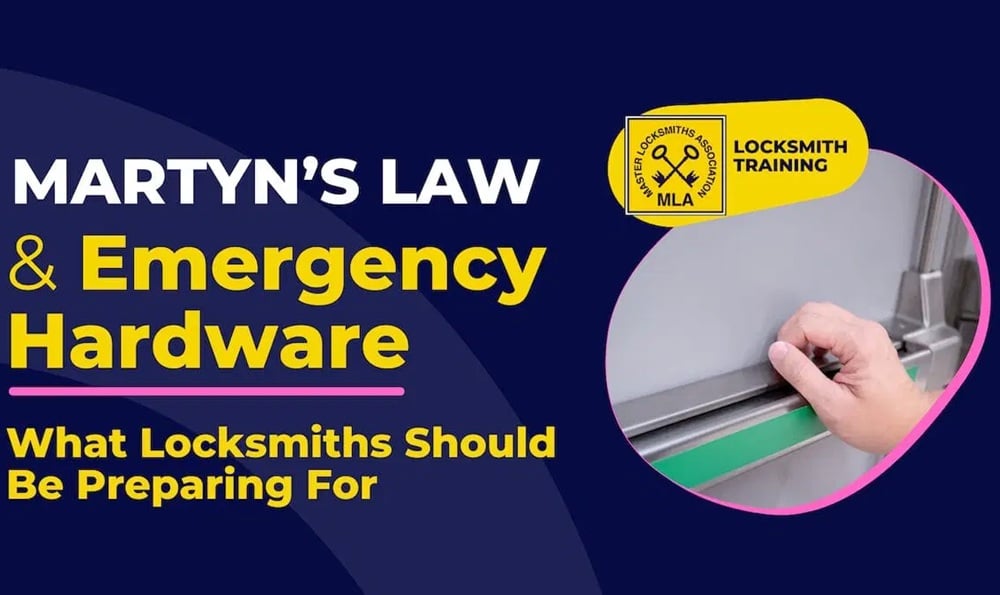For locksmiths, the changes brought about by Martyn’s Law bring important professional considerations — from legal compliance and technical requirements to business development and training, so says The Master Locksmiths Association (MLA), in a new blog on its website.
Martyn’s Law – officially known as the Terrorism (Protection of Premises) Act 2025 – introduces new legal responsibilities for venues across the UK. The legislation aims to reduce the risk of terrorism in publicly accessible spaces by requiring venues to improve their emergency preparedness and security.
What Is Martyn’s Law?
Martyn’s Law is named after Martyn Hett, one of the victims of the 2017 Manchester Arena bombing. It was passed in April 2025 and will come into full legal effect in April 2027, giving venues two years to prepare.
Who Does It Apply To?
Any publicly accessible venue with a capacity of 200 people or more, including:
- Theatres, cinemas, and live entertainment venues
- Stadiums and arenas
- Nightclubs and music venues
- Shopping centres and retail parks
- Universities, schools, and colleges
- Large places of worship and event spaces
Venue Obligations by Tier:
Standard Duty Premises (200–799 people): Expected to notify relevant authorities and have basic public protection procedures in place, where reasonably practicable
Enhanced Duty Premises (800+ people): In addition to standard requirements, expected to consider further public protection measures, including monitoring and planning, and to document procedures as appropriate
Why Panic Hardware Matters
At the heart of emergency preparedness is the ability to evacuate safely and quickly. That’s where panic hardware — such as push bars and crash bars — becomes critical.
What Is Panic Hardware?
Panic hardware is a door mechanism that allows rapid exit without the use of keys or prior knowledge. It’s typically used on emergency exits and is required in many public venues by fire and building regulations.
Legal and Safety Criteria:
- Must comply with BS EN 1125 (for public spaces) or BS EN 179 (for trained personnel areas)
- Must be easy to operate under pressure
- Must be installed and maintained to a professional standard
- Improper installation or outdated equipment can compromise public safety — and expose venue owners to legal risk.
A Timely Opportunity: MLA Training for Locksmiths
To support locksmiths in this area of locksmithing, the Master Locksmiths Association (MLA) has introduced a dedicated locksmith training course focused on emergency and panic hardware.
What You’ll Learn:
- Relevant British and European Standards (BS & EN) for panic and emergency hardware and their application
- How to choose/specify the right hardware for each type of door and scenario
- Hands on installation methods covering different types of emergency exit hardware and door types ensuring it is fitted correctly
- You’ll get hands-on experience fitting ISEO emergency exit hardware to a range of door types. This practical work will help you install with confidence in real-world situations.
Why Take This Course?
- Will enable you to confidently specify and install ISEO emergency exit hardware to a variety of door types
- You’ll understand the legal and safety standards that apply
- You’ll be listed by Marcus Ltd as an approved installer of ISEO emergency exit and panic hardware
- Delivered by industry experts
- Designed for practical, real-world use
Successful completion earns you a Certificate of Competency, proving you were assessed and considered competent to safely install emergency exit and panic hardware at the time of training.
Find out more, here
Final thoughts: Prepare, Don’t Panic
Martyn’s Law is a significant step toward making public venues safer. It also marks a shift in how security is managed — not just with CCTV and guards, but with infrastructure and systems that work when it matters most.
As a locksmith, you’re well-placed to support this effort. By considering the legal, technical, and business aspects now, you can ensure you’re ready — and trusted — when demand grows.
Find out about the Emergency Exit Hardware Course, here
For more access control news, click here





